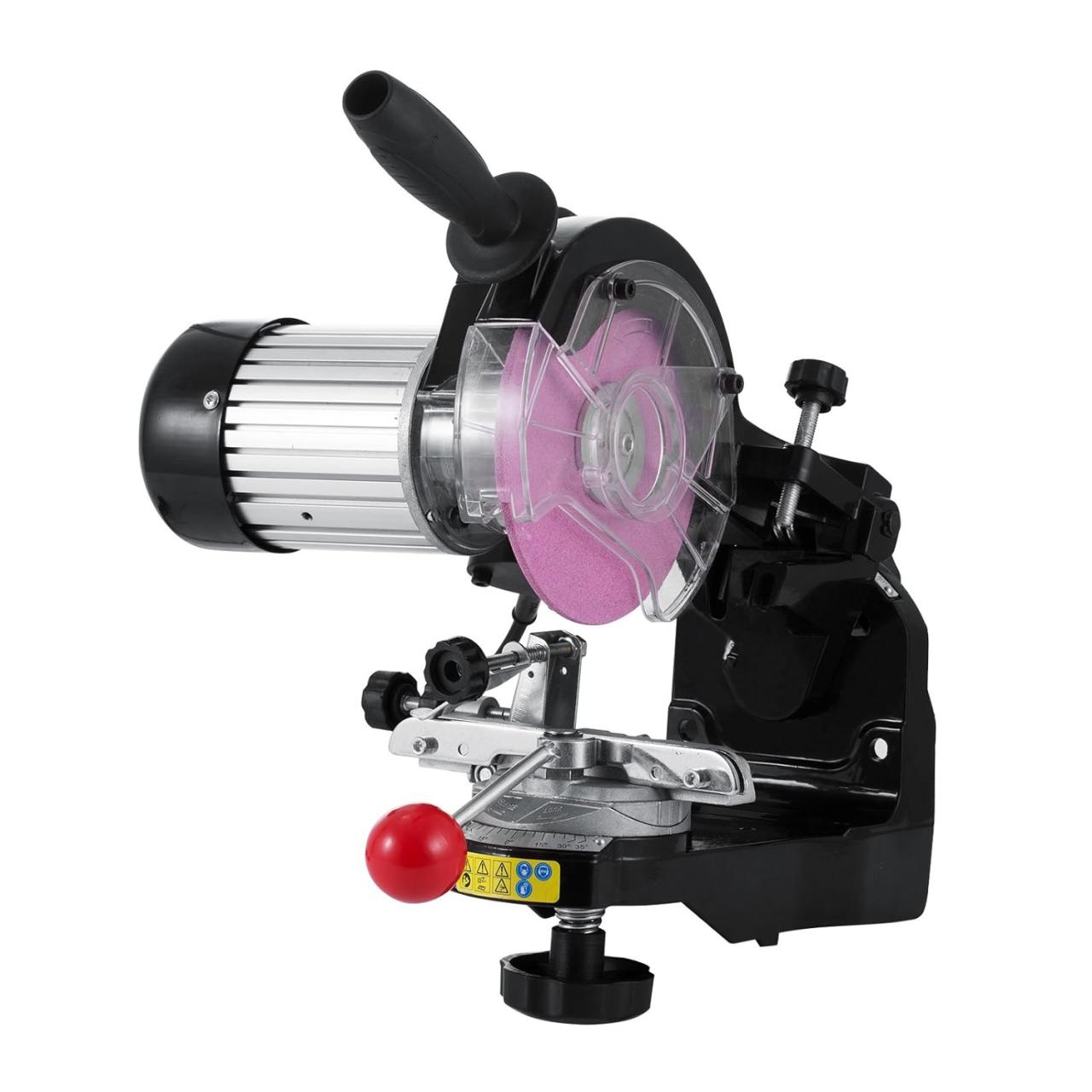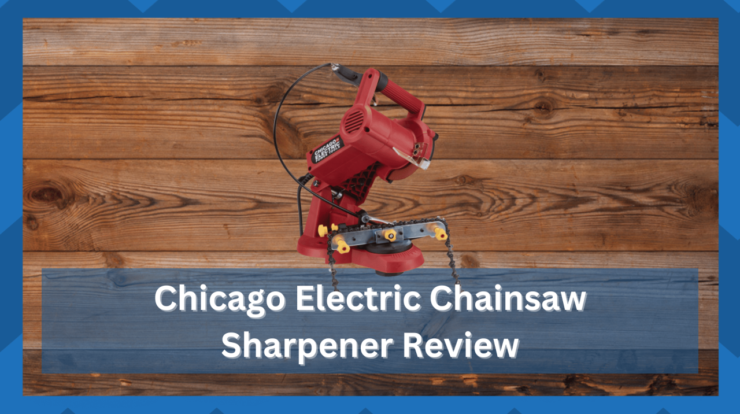Electric chainsaw sharpeners revolutionize the sharpening process, offering precision, speed, and ease of use. Dive into this comprehensive guide to explore the types, benefits, features, usage, maintenance, and frequently asked questions surrounding these indispensable tools.
From understanding the distinct capabilities of various electric sharpeners to maximizing their performance, this guide equips you with the knowledge and skills to maintain sharp and efficient chainsaws.
Types of Electric Chainsaw Sharpeners
Electric chainsaw sharpeners are invaluable tools for maintaining the sharpness of your chainsaw blades, ensuring optimal cutting performance. They come in various types, each with its own distinct features and capabilities.
Benchtop Models
Benchtop electric chainsaw sharpeners are stationary units designed for use in a workshop or garage. They provide a stable and secure platform for sharpening, allowing for precise control and accuracy. Benchtop models typically feature adjustable grinding angles and speeds, enabling you to customize the sharpening process according to the specific requirements of your chainsaw blade.
Handheld Models
Handheld electric chainsaw sharpeners are portable and lightweight, making them ideal for on-site sharpening. They are typically powered by batteries or AC power, providing convenience and flexibility in any work environment. Handheld models are often equipped with quick-release mechanisms for easy blade attachment and removal, ensuring efficient sharpening.
Automatic Models
Automatic electric chainsaw sharpeners are designed to simplify the sharpening process. They feature automated grinding mechanisms that guide the blade through the sharpening process, eliminating the need for manual adjustments. Automatic models are ideal for users who value ease of use and consistency in their sharpening results.
Manual Models
Manual electric chainsaw sharpeners require more user input compared to automatic models. They typically consist of a grinding wheel and a guide that allows you to manually control the sharpening angle and depth. Manual models offer greater flexibility and customization, but they require a higher level of skill and experience to operate effectively.
Advantages and Disadvantages
Each type of electric chainsaw sharpener has its own advantages and disadvantages:
- Benchtop models:Stable and precise, but less portable.
- Handheld models:Portable and convenient, but may lack the precision of benchtop models.
- Automatic models:Easy to use and consistent, but less customizable.
- Manual models:Flexible and customizable, but require more skill to operate.
Benefits of Using an Electric Chainsaw Sharpener
Electric chainsaw sharpeners offer numerous advantages over manual sharpening methods, revolutionizing the sharpening process for chainsaw users. These sharpeners are designed to provide precision, accuracy, and efficiency, making chainsaw maintenance a breeze.
Precision and Accuracy
Electric chainsaw sharpeners employ advanced sharpening mechanisms that ensure consistent and precise sharpening angles. Unlike manual methods, which rely on the user’s skill and experience, electric sharpeners remove material evenly and accurately, resulting in sharp and well-balanced chains. This precision translates into improved cutting performance, reduced vibration, and increased chainsaw lifespan.
Time-Saving and Efficiency
Electric chainsaw sharpeners significantly reduce the time and effort required to sharpen a chain. The automated sharpening process eliminates the need for tedious hand filing and guesswork. With electric sharpeners, users can sharpen their chains quickly and efficiently, saving valuable time and ensuring their chains are always ready for use.
Features to Consider When Choosing an Electric Chainsaw Sharpener
When selecting an electric chainsaw sharpener, consider these crucial features to ensure optimal sharpening quality and performance:
Sharpening Angle
The sharpening angle determines the sharpness and durability of the chain. Choose a sharpener that allows for precise angle adjustments to match the manufacturer’s specifications for your chainsaw.
Sharpening Speed
The sharpening speed affects the efficiency and convenience of the process. Faster sharpeners can save time, but slower speeds may provide more control and accuracy.
Ease of Use
Look for sharpeners with intuitive controls, clear instructions, and a user-friendly design. This ensures ease of operation, even for beginners.
How to Use an Electric Chainsaw Sharpener
Using an electric chainsaw sharpener is a straightforward process that can be completed in a few simple steps. By following these instructions carefully, you can ensure that your chainsaw is properly sharpened and ready to use.
Safety Precautions, Electric chainsaw sharpener
- Always wear safety glasses and gloves when operating an electric chainsaw sharpener.
- Ensure that the sharpener is securely mounted on a stable surface.
- Keep your hands away from the rotating grinding wheel.
- Never attempt to sharpen a chainsaw while it is running.
Setting Up the Sharpener
1. Assemble the sharpener according to the manufacturer’s instructions.
2. Connect the sharpener to a power source.
3. Adjust the grinding wheel to the correct angle for your chainsaw.
Positioning the Chainsaw
1. Place the chainsaw on the sharpener’s support bracket.
2. Align the cutting teeth of the chainsaw with the grinding wheel.
3. Secure the chainsaw in place using the clamps provided.
Operating the Machine
1. Turn on the sharpener and allow the grinding wheel to reach full speed.
2. Slowly lower the chainsaw onto the grinding wheel, applying gentle pressure.
3. Move the chainsaw back and forth across the grinding wheel, sharpening each tooth.
4. Continue sharpening until all of the teeth are sharp.
5. Turn off the sharpener and allow the grinding wheel to stop completely.
Tips
- Use a light touch when sharpening the chainsaw.
- Sharpen the teeth in a consistent pattern.
- Check the sharpness of the teeth regularly using a file.
Maintenance and Care of Electric Chainsaw Sharpeners
Regular maintenance and care are crucial for ensuring optimal performance and extending the lifespan of your electric chainsaw sharpener. By following these simple procedures, you can keep your sharpener running smoothly and efficiently.
Cleaning
Regular cleaning is essential to remove sawdust, metal shavings, and other debris that can accumulate during use. Use a soft brush or compressed air to remove loose particles. For more thorough cleaning, disassemble the sharpener and wipe down the components with a clean cloth and a mild detergent solution.
Ensure the sharpener is completely dry before reassembling.
Lubrication
Proper lubrication reduces friction and wear on the moving parts of the sharpener. Apply a few drops of light machine oil to the gears, bearings, and other moving parts as recommended by the manufacturer. Avoid over-lubricating, as excess oil can attract dirt and debris.
Inspection
Periodically inspect the sharpener for any signs of damage or wear. Check the grinding wheel for cracks or uneven wear, and replace it if necessary. Inspect the motor and other electrical components for any loose connections or damage. Promptly address any issues to prevent further damage and ensure safe operation.
Troubleshooting Common Issues
Sharpener not starting
Check the power cord and electrical connections. Ensure the power switch is turned on.
Grinding wheel not spinning
Inspect the motor and grinding wheel for damage. Check the power supply and ensure the sharpener is properly plugged in.
Excessive vibration
Tighten any loose screws or bolts. Ensure the sharpener is placed on a stable surface.
Extending Lifespan
- Store the sharpener in a dry and dust-free environment.
- Avoid using the sharpener in wet or dusty conditions.
- Regularly clean and lubricate the sharpener as recommended.
- Replace worn or damaged parts promptly.
- Follow the manufacturer’s instructions for proper use and maintenance.
Closing Notes

Mastering the art of electric chainsaw sharpening empowers you to tackle any cutting task with confidence. By embracing the insights provided in this guide, you can ensure that your chainsaw remains a reliable and efficient partner in your outdoor endeavors.
Query Resolution
Can electric chainsaw sharpeners sharpen all types of chainsaws?
Yes, most electric chainsaw sharpeners are compatible with a wide range of chainsaw models and chain types.
How often should I sharpen my chainsaw chain?
The frequency of sharpening depends on usage and cutting conditions. Generally, it’s recommended to sharpen the chain after every 5-10 hours of use.
Can I use an electric chainsaw sharpener on a dull chain?
Yes, electric chainsaw sharpeners are designed to restore sharpness to dull chains. However, severely damaged or excessively worn chains may require professional repair.
